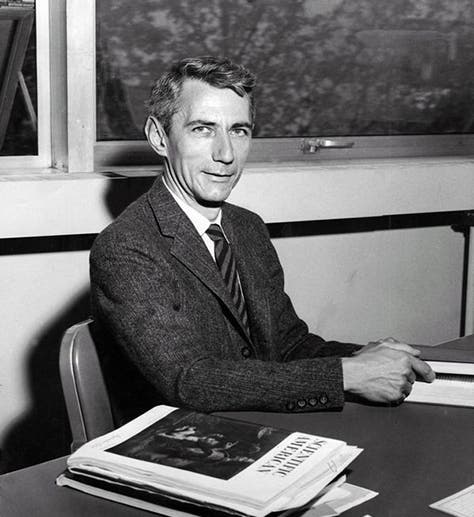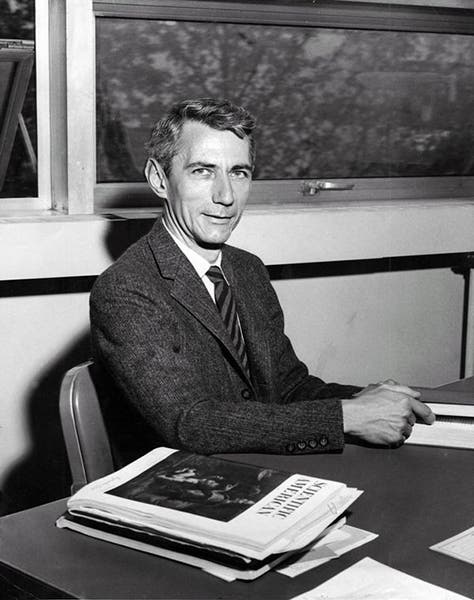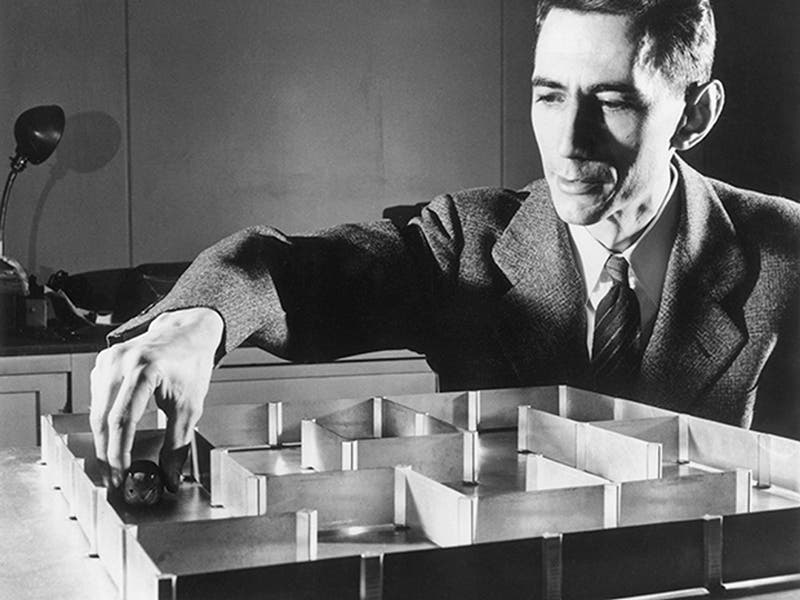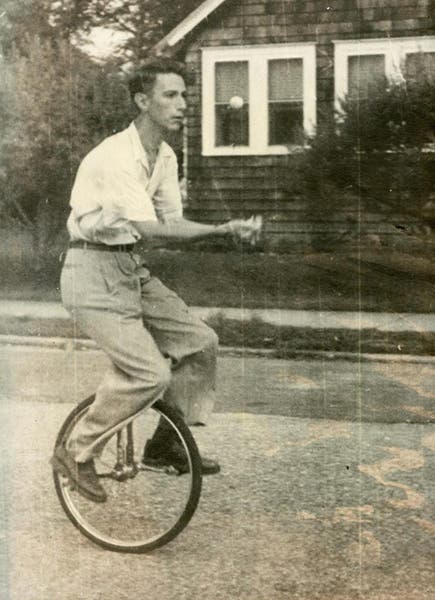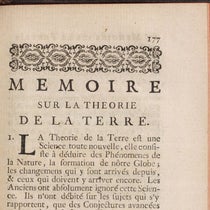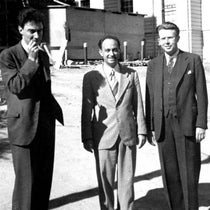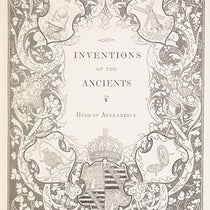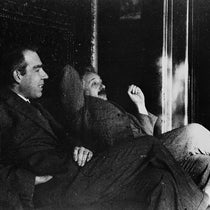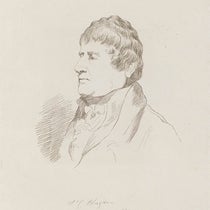Scientist of the Day - Claude Shannon
Claude Shannon, an American information theorist, died Feb. 24, 2002, at the age of 84. Shannon was in fact THE information theorist, the founder of that discipline, which he created with a milestone paper, “A mathematical theory of communication," published in the Bell System Technical Journal in two parts in 1948. Shannon was able to show, mathematically, just what is involved when we "communicate", that is, when we encode a message, send it from one place to another, and decode it. He was able to demonstrate that the basic unit of information, the bit (a term we owe to Shannon), is just a measure of entropy, the unit in thermodynamics that measures the disorder of a system. When we send a 1 or a 0, to indicate yes or no, on or off, we are sending one bit of information, at the cost of a slight increase in entropy. If we send the letter "a", we convey much more information, because there are 25 other possibilities that are eliminated with the transmission of "a", whereas a binary signal can only be a 0 or 1.
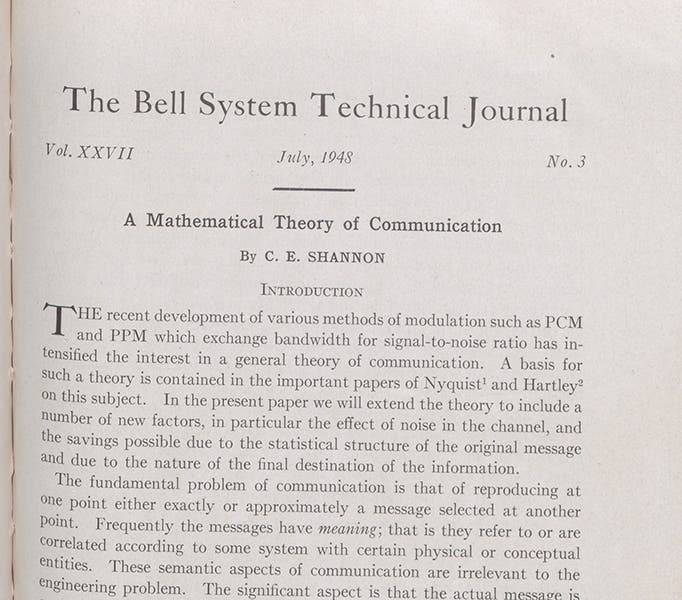
First paragraph of “The mathematical theory of communication,” by Claude Shannon, Bell System Technical Journal, vol. 27, p. 379, 1948 (Linda Hall Library)
Perhaps Shannon's most important discovery concerned information loss, which can occur with most communications, due to noise or error. Shannon was able to prove that, by proper encoding and with a little redundancy added in, it is possible to send a nearly lossless signal, no matter how noisy the transmission. This is sometimes called Shannon’s second theorem, and it has formed the basis of nearly all modern communication systems, where checks are built in so that any error can be immediately detected and corrected. Without it, the internet, satellite communications, and data compression would be impossible. In the annals of famous scientific papers, Shannon's has to be ranked right up there with that of Watson and Crick on the DNA double helix (1953), and even, many say, with Albert Einstein’s paper on special relativity (1905) and general relativity (1916). If you go searching for the Bell System Technical Journal in our Library, you will find all the volumes in the stacks except the one for 1948, which we keep secure in the History of Science Collection. Our copies of the July and October issues for 1948 have been bound into a volume; if you would like the original issues in their paper-bound covers, you are in luck, as our dealer friend Sophia Rare Books has a set just waiting for you. If it is marked sold, you are too late.
In addition to contemplating communications theory, Shannon liked to work with his hands, and in 1950 he built a maze-solving mouse that was quite remarkable. He called the mouse Theseus, in honor of the Greek maze-runner who escaped the labyrinth of the Minotaur; we include a photo of Shannon, Theseus, and its aluminum maze (third image). Shannon would place the mouse at the beginning of the maze, and a piece of ersatz cheese at the end; the mouse would whir along, bouncing into walls and haphazardly tracing out a path that eventually, by sheer happenstance, ended at the cheese. But sensors were recording every twist and turn, and when Shannon now repositioned Theseus at the start, Theseus would cruise through the maze without a single error. It had learned, and stored that learned knowledge for later use. In truth, Theseus hadn’t learned anything – Theseus was just a magnet wrapped inside a piece of cloth on wheels. But its every action was recorded by sensors beneath the maze and a large bank of telephone relays, which served as a memory storage unit, and which did learn, and then relayed instructions to magnets under the maze that controlled the mouse. In effect, Shannon built a programmable computer out of electro-magnetic relays, at a time when the first programmable computer, ENIAC, was only four years old, and it had used vacuum tubes, not telephone relays. Theseus was an amazing achievement. There is a YouTube video (6 minutes long) that shows Shannon himself demonstrating Theseus, apparently made by Bell Labs in 1952 as a promotional film; it is a good introduction to both Shannon and Theseus.
And just to make a rich subject even richer, we must mention Claude Shannon the juggler. He learned to juggle at an early age, and after he had moved on from Bell Labs to a professorship at MIT, he would join the undergraduate Jugglers Cub on Sunday for their get-togethers. Naturally, Shannon couldn’t help thinking about the mechanics of juggling, and he constructed an automaton that could ��“bounce” juggle. Here is a short video of Shannon’s mechanical juggler at wok, or perhaps at play. There even survives a photo of a young Shannon juggling – on a unicycle! (fourth image).
Shannon is truly one of the unsung heroes of 20th-century science – unsung, at least, to those of us who are not information theorists. To those who are, Shannon is the unrivalled giant of their field, their Einstein. Information theory, unlike the genetic code, was not just waiting to happen. Shannon made it happen; he established the entire framework of information theory out of nowhere, and indeed, it would be another 20 years before his contribution was really understood, and modern information theory was built upon his conclusions and equations.
The many photos of Shannon that survive present him as a lanky, amiable, impish, likeable fellow, and even the brilliance seems to shine through. He is definitely one of those historical figures you would like to have dinner with if you could travel back in time (taking your iPhone with you).
William B. Ashworth, Jr., Consultant for the History of Science, Linda Hall Library and Associate Professor emeritus, Department of History, University of Missouri-Kansas City. Comments or corrections are welcome; please direct to ashworthw@umkc.edu.

